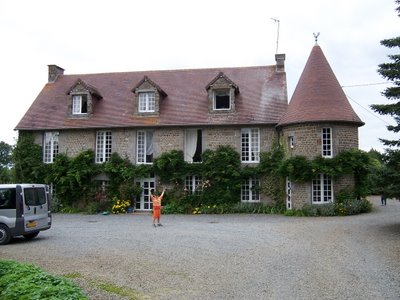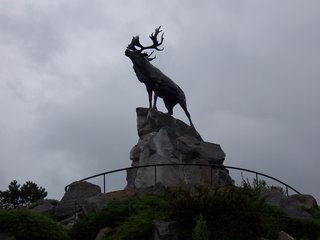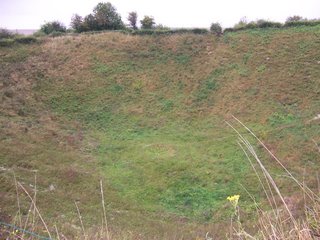We started driving back to Holland on August 24. The plan was make about half of the trip, visit some WWI sites in Northern France, stay at a B&B in the very north of France, and continue home to Holland on the 25th.
Our B&B, pictured below, in St. Pience was about as French as you can get. When Nancy looked out the window in the morning, a man was walking up the lane carrying a basket laden with loaves of french bread, and, when we walked into the dining room, we were greeted by softly playing French music. Ahhh, viva la France!

Before setting out on our trip north we stocked up on fruit, bread, brie and ham which made for a delicious lunch at a pullout.
Our first stop of day was to be at Beaumont Hamel, a site that I didn't know about until I read an article in the Vancouver Sun this past July 1st (Canada Day) about the Newfoundland Regiment and the great number of casualties that they suffered on the first day of the Battle of Somme on July 1, 1916. For a great number of reason, the Regiment suffered 85% casualties (dead or wounded) in the first 15-20 minutes.
The loss was so great that for the past 90 years, July 1st has been a day of mourning for the province of Newfoundland.And due to this fact, in the second WW, any soldier from Nfld regiment was not given frontline duties. Both Dad and I were intrigued and wanted to visit the site.
As we made our way there we noticed a large memorial on a hill, the Thiepval Memorial. I had read about it, and didn't think we had time, but as it was on the road to Beaumont Hamel, we decided to stop in. The Memorial is to all the missing British soldiers of WWW1, numbering more 72,000. The size of the memorial, the impact of the loss, and the 72,000 names inscribed on it's supports is staggering. It was cold windy and rain and we needed to hurry to Beamont Hamel before it closed, so we didn't stay long but there was an excellent multi media interpretive centre just below it.

At Beaumont Hamel we had a tour (just the 6 of us) from Matthew from New Brunswick. Canada has an excellent student program, where for a 4 months, Canadian students staff these sites.
I won't go into all the details of the Beaumont Hamel story and the Battle of the Somme but it was humbling to see the old British/Newfoundland trench lines, look across no man's land to where the German trench system was, and to stand beside the Danger Tree that so many Newfoundlanders lost their lives at.
 The Newfoundland Regiment at Beaumont Hamel. The woodland cariboo is native to Newfoundland and has its head, mouth open with the anguished cry for the dead, facing toward the enemy lines. The cariboo was chosen because it travels in packs and never leaves behind one of its own.
The Newfoundland Regiment at Beaumont Hamel. The woodland cariboo is native to Newfoundland and has its head, mouth open with the anguished cry for the dead, facing toward the enemy lines. The cariboo was chosen because it travels in packs and never leaves behind one of its own. You can see how overcast it was that day. Matthew said that it was a perfect day to visit the Somme as in 1916 it was very wet and the battlefields were a sea of mud. 90 years later we had niced paved trails to walk on.
We may have stayed longer but it was still cold wet and windy and we needed to make tracks to our B&B at Lille.
Before doing so we stopped in at the Longueval Carter. You may know that during the trench warfare of WWI, each side would dig tunnels under the enemy's trenches and explode a massive amount of explosives. The Longueval Mine, if memory serves, was about 20-25 tons of explosives and obliterated 9 German dugouts. The crater left behind is unimaginably huge, perhaps 60 feet deep and hundreds of feet across. How many men lost their lives in an instant is incomprehensible. A footpath snakes down the side of the crater and at ground zero at the very bottom is a memorial of many little poppies. The immense mine crater at Longueval
The immense mine crater at Longueval
As we contined north along the road, past so many memorials and graveyards to the British, French, Australians, South African, Welsh .... the list goes on and on...as did the graveyards. The Battle of the Somme was a meatgrinder and the number of graveyards and memorials is a testimony to the human cost. In my mind I called this stretch of road north of Albert, "The Highway of Tears". It seemed your were hardly ever out of sight of the cost of war.
(I'm running our of time tonight, but do ask me about the angel that came out of her home to rescue us while we were hopelessly lost!)
Our B&B that night in Lille was an exceptional treat. We elected to spent our last evening in France having a homecooked French meal. The B&B is an 18th century farm and we had dinner with the proprieters, Dominique and Nelli, a couple from Tolouse France and the 6 of us. It was a very completely enjoyable 2 hour meal. Maincourse was chicken, potatoes amnd carrots from their farm, followed by a sampling of 4 kinds of cheese (I wrote down the names but can't find it right now). Not brie or camembert, oh no! These are cheeses that for the most part you will never see outside northern France has they are made only on one farm and are only sold at the farm or local market. We were taught to eat from mild to strongest. Lastly was dessert and beauiful, rich, dark coffee. The wine was delicious as well and all the time we had a lovely conversation, in English and our pigdin French, with our tablemates. A very pleasant way to end our time in France.
All for now, S.

0 Comments:
Post a Comment
<< Home